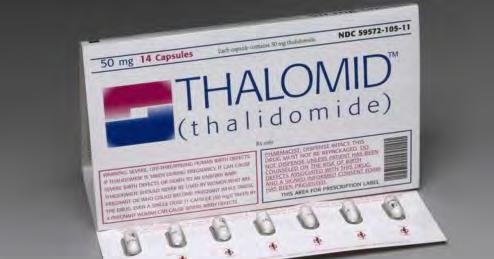
1 minute read
Thalidomide
Thalidomide was first developed by a Swiss pharmaceutical company in the early 1950s.
The drug was initially advertised as a sedative which would allow users to undergo a deep sleep in the absence of a hangover and with a reduced risk of developing drug dependency. At the time, basic testing was done on the drug, and it was considered not to have any toxic effects on humans.

Following its release, the drug became popular as a morning sickness remedy for pregnant women. This increase in use for pregnant women was aided by the fact that the drug could be obtained without a prescription and was affordable. However, following its widespread use in Japan, Australia, and Europe, practitioners noticed links between mothers who had taken thalidomide and the presence of congenital mutations in their children. Therefore, thalidomide was removed from the market in many countries in 1961. Thalidomide was sold as the racemic mixture of enantiomers. (+)(R)-thalidomide is a sedative, but (-)(S)-thalidomide is a teratogen (i.e., a drug which can harm a foetus in the womb). (-)(S)-thalidomide inhibits new blood vessel growth. This is detrimental to a foetus because new blood vessels provide a “road map” for the growth of limbs and organs during the development of a foetus.


Thus, (-)(S)-thalidomide is the unwanted enantiomer. You might think that drug companies can simply purify the racemic mixture and give patients only the (+)(R)thalidomide. Unfortunately, the answer is not that simple. Human liver contains an enzyme that can convert (+)(R)-thalidomide to (-)(S)thalidomide. Therefore, even administration of enantiomerically pure (+)(R)-thalidomide results in a racemic mixture.
Some drug manufacturers are conducting trials to see if thalidomide can cure breast, prostate, brain, lung, and pancreatic cancer. Thalidomide can inhibit new blood vessels forming in and around tumours, doctors hope that the drug can kill tumours directly by shutting down the blood supply to them.










